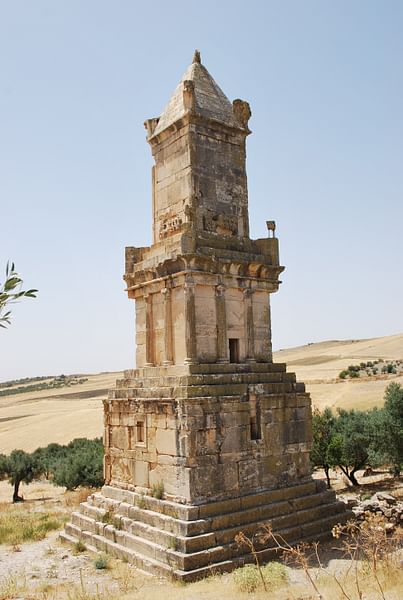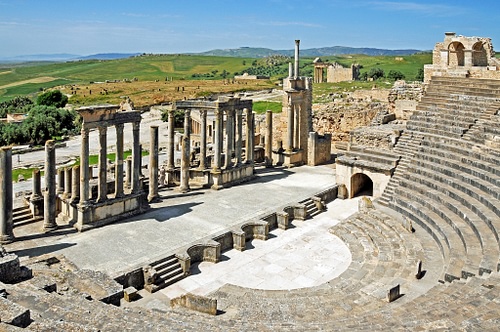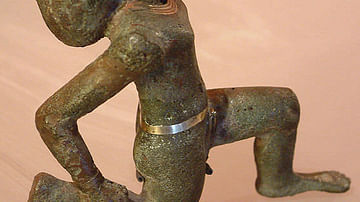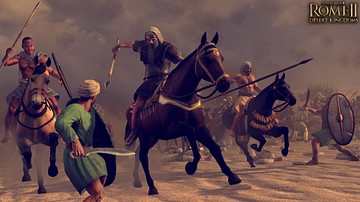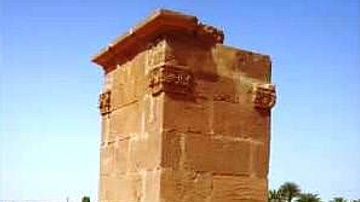
Thugga (also Dougga) was a town in North Africa which was first a Numidian and then a Carthaginian settlement before being incorporated into the Roman Empire. The town was built on a strategically favourable limestone hilltop overlooking the fertile Wadi Khaled Valley (modern Tunisia) and particularly flourished during the 2nd and 3rd centuries BCE. The archaeological site has substantial remains which include a theatre, baths, mausoleum, and temples. Thugga is a UNESCO World Heritage site.
Numidian-Punic Thugga
Thugga was first settled in the Bronze Age if not before. It first appears in the wider historical record when it was conquered by Agathocles of Syracuse in the 4th century BCE. It, then, became an important Numidian town from the reign of Masinissa (r. 238-148 BCE) when Numidia was an ally of nearby Carthage, 130 km to the northeast. A temple was built and dedicated to the Numidian king and also from this period a mausoleum of a Numidian noble survives. It carries inscriptions in both Numidian and Punic, illustrating the close ties between the two cultures. Indeed, Thugga was located almost at the very border, the fossa regia, between the Carthaginian and Numidian spheres of influence. The town's prosperity in this period is further attested by finds from tombs of jewellery, glass vessels, and pottery from as far afield as Greece and Italy which even include wine amphorae from Rhodes.
Roman Thugga
When Rome defeated Carthage an influx of Marian settlers arrived at Thugga (according to some historians but not agreed on by all). Roman influence increased further following the Battle of Thapsus in 46 BCE. Parts of the territory of the town were controlled by the colonia of Carthage which led to a complex dual administration still debated by scholars. The indigenous and Numidian residents (civitas) were governed by the local suffetes (Punic judicial administrators) while the Roman populace (pagus) looked to Carthage for their governance. The system was not simplified until Roman emperor Septimius Severus unified the administration and made Thugga a municipium in 205 CE. Then in 261 CE Thugga became a colonia in its own right. From the 3rd century CE, Thugga sent bishops to councils held at Carthage but the town conspicuously lacks the large Christian buildings seen in other towns of the region.
In the Byzantine period, the town was fortified around the forum and a small fort constructed. Although never wholly abandoned, such was the diminished status of the town from Late Antiquity that there was never a necessity to reuse the building materials of the towns more ancient monuments. As a consequence, they have survived remarkably well and have earned the site UNESCO World Heritage status.
Archaeological Remains
Thugga has substantial remains which include the mid-2nd century BCE three-storied Numidian-Punic mausoleum monument with its bilingual inscription. Historians continue to debate whether the name of Atban mentioned in the partial inscription refers to the mausoleum's architect or occupant. The inscription also names various skilled workers suggesting the city was prosperous enough to support such professionals. The tower-like monument is an eclectic mix of architectural styles with Ionic columns, Aeolic capitals, and Egyptian mouldings all topped with a pyramid-shaped roof.
There are three Roman temples: the Capitolium temple was built c. 166 CE and dissected the forum; the temple dedicated to Caelestis, a local epithet of Juno and linked to Tanit (222-235 CE); and the temple of Saturn-Baal (195 CE). The theatre of Thugga was constructed c. 168 CE and was set into the hillside on the east side of the town. A triumphal arch built during the reign of Septimius Severus in 228 CE also survives. There are remains of two Roman baths, the principal municipal baths being the Licinian baths which were built incorporating the local topography, like much of the architecture at Thugga.
Finally, there are private villas and housing, many of which have well-preserved mosaic flooring, and the Byzantine fort built on the site of the Roman forum. Portions of the city's fortifications built to ward off the Vandal raids also survive. Besides buildings, Thugga provides several large stelae from the late Punic era. The earliest date to the 3rd century BCE and still carry Phoenician motifs such as winged disks while the latest, from the 1st century BCE, display an evolution in the use of the Tanit symbol and so a continuing Punic cultural influence.
